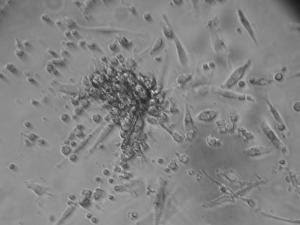
The Cardiology department and the Area of Cell Therapy of Cordoba hospital Reina Sofia are carrying out clinical tests with patients who have suffered from a severe heart attack. With the implantation of the patient's stem cells, the heart regenerates thus improving its wall motion, that is, its cardiac performance. Indeed for the last four years, the Area of Cell Therapy of Cordoba hospital, led by haematologist Dr. Concha Herrera, has been implementing a therapy program with adult stem cells in patients with heart-related problems. However, this therapy is not a service the hospital offers yet. More specifically, at the end of 2007 the hospital ended a clinical test with patients who had suffered a severe myocardial infarction, that is, an obstruction of one of the main coronary arteries that stops the blood pump to the heart.
The test consisted of treating 30 people split into three groups of ten each at random. The first group was the control group, where patients received standard treatment for acute myocardial infarction; the second group was treated with stem cells directly implanted into the coronary artery affected using a catheterization; the third group was treated with a medicine called G-CSF, which makes cells move from the marrow to the blood, so that they get to the heart in a natural way, without having to do so through a catheter.
At the end of the test, the results revealed that the two groups treated without cells improved slightly, whereas patients transplanted with stem cells through the coronary arteries (vessels which bring the blood to the Herat muscle) did improve their ventricular function much more. This was interpreted as a significant decrease of the cardiac failure symptoms such as pain, fatigue and breathlessness when making small efforts.
Moreover, with this process it is possible to prevent some acute arrhythmias (change or irregularity in the rhythm of the heartbeat), which in many cases could result in the patient's death. ‘However, it does not prevent a future heart attack', Dr. Herrera assures.
In short, the stem cells transplanted from the marrow into the heart muscle have a double function: on the one hand they regenerate the heart cells, the cardiomiocites. In addition to this, they segregate a series of proangiogenic factors that produce blood vessels (angiogenesis) and can also produce the recruitment of stem cells that are in the myocardium itself.
The Are of Cell Therapy, led by Dr. Herrera, is currently developing other trials in the cardiology department, both in patients with acute myocardial infarction (35) and in those with chronic ischemic cardiopathy, due to one or more heart attacks suffered in the past, either months or years ago (20 patients). Moreover, in the last few months a new clinical trial has been started - so far in eight patients- who suffer from a disease called Dilated Myocardiopathy. The origin of this disease is unknown but it causes a very severe cardiac failure which conditions the need for a heart transplant in many cases. So far, ‘the results in these first patients are very satisfactory'.
'We will start shortly a clinical test where we will use stem cells from the marrow in diabetic patients who have the artery taking the blood to the lower limbs blocked. This pathology, called peripheral ischemia, can result in a limb being amputated'.
This work, published in Revista Española de Cardiología journal, has been awarded with a prize by the Sociedad Española de Cardiología.
Spiga
INTERNAL MEDICINE The internal medicine blog , where you can have details on alternatice medicine , latest trends in medicine , new drugs in the market , school of medicine etc
Stem Cells Transplanted From Marrow Into Heart May Improve Heart's Performance
Thursday, May 28, 2009 at 8:44 PM Posted by Sajith
Subscribe to:
Post Comments (Atom)
Search
Labels
- Alzheimer's (10)
- Antibiotics (7)
- Anxiety (1)
- articles (2)
- Bacteria (1)
- behavioral abnormality (1)
- Bio technology (1)
- Brain (8)
- breast cancer (6)
- Cancer (40)
- cancer treatment (7)
- chemotherapy (6)
- Chlamydia (1)
- Cytology (3)
- Death (1)
- Diabetes Mellitus (7)
- Diet (17)
- DNA (1)
- Doctors (1)
- epilepsy (2)
- Fossil (1)
- fruits (1)
- genes (6)
- Genetics (13)
- Geriatrics (1)
- Health (12)
- Heart diseases (9)
- Herbal Medicine (2)
- HIV and AIDS (7)
- influenza (1)
- Inventions (1)
- IVF (1)
- latest findings (1)
- Life style (2)
- Lung Cancer (1)
- Lung Disease (9)
- Microbiology (1)
- Multiple Sclerosis (1)
- Nanotechnology (3)
- Neonatology (1)
- neurology (1)
- News (18)
- Parkinsonism (2)
- Prevention (1)
- Primates (1)
- Prostate cancer (1)
- Prosthetics (1)
- seizure (2)
- Skin (1)
- STD (2)
- Stem cells (9)
- Stroke (1)
- Surgery (2)
- Swine flu (11)
- Virus (1)
- weight loss (1)
Search The Web
Blogger Template by B-Themes | 2008
Minyx v2.0 template es un theme creado por Spiga. | Minyx Blogger Template distributed by eBlog Templates

0 comments:
Post a Comment